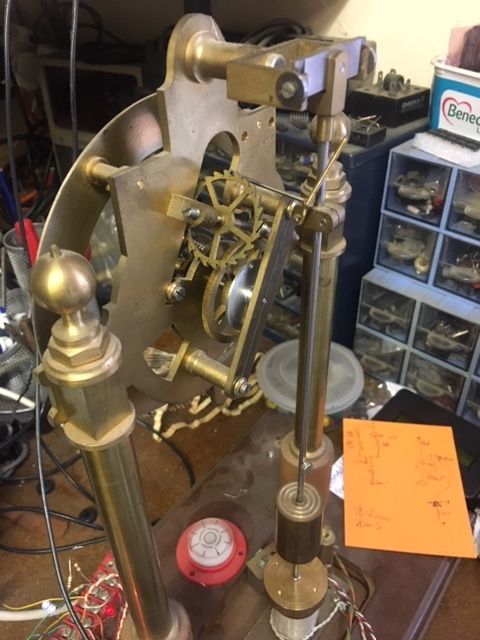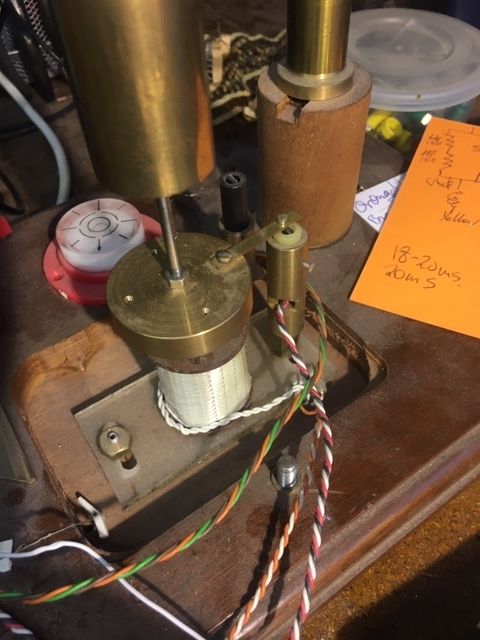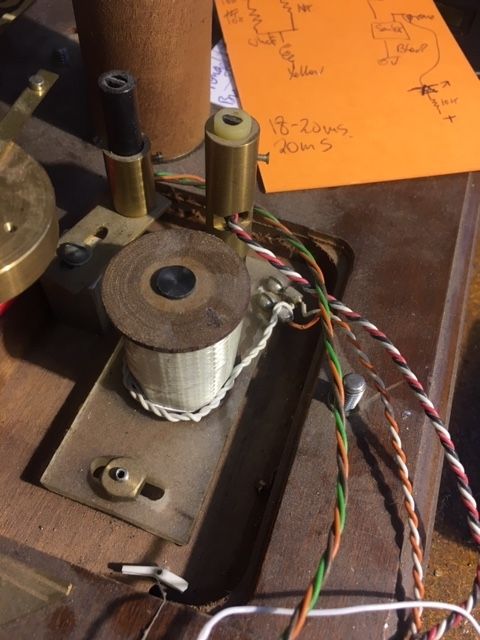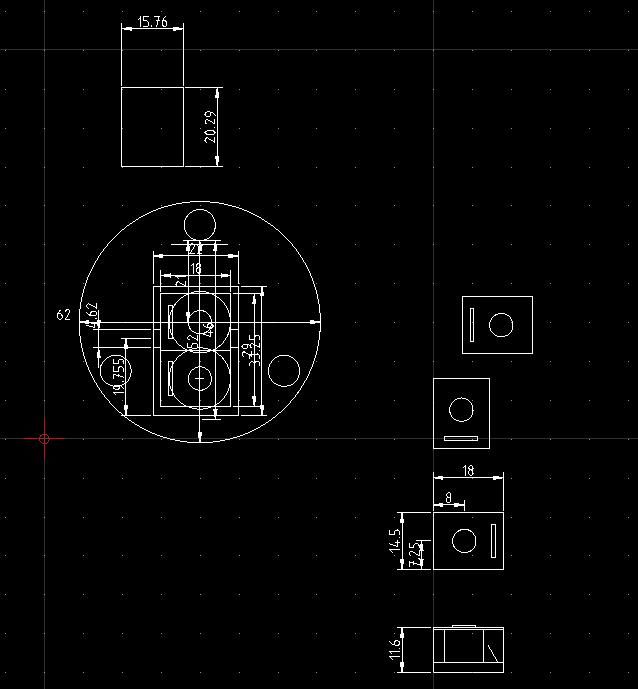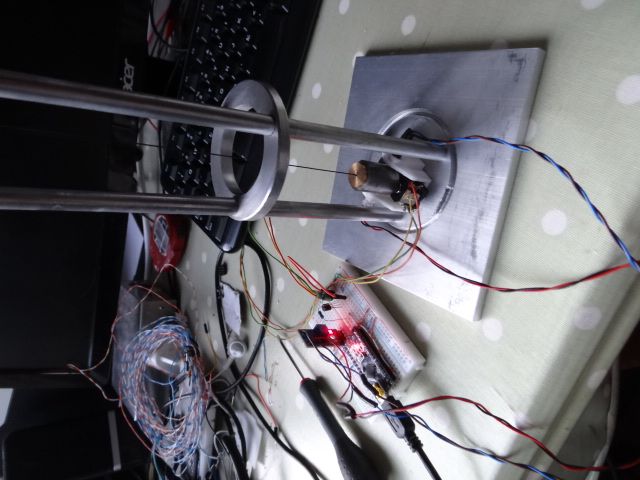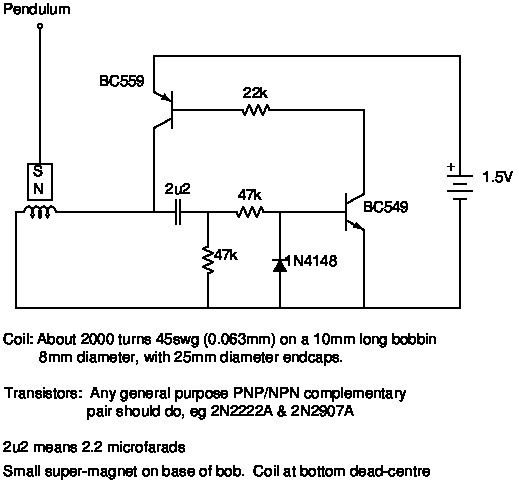Posted by Marcus Bowman on 14/09/2020 23:31:42:
…
There is a flat coil (no centre iron) which acts both as detector and as impulser (at least that's he theory). The original used two concentric coils, one for sense and the other for impulse, but I think more than one coil is unnecessary.
…
problem is that because the magnetic field is doughnut-shaped, the pendulum will tend to move in a slightly circular or elliptical path. Restraining the pendulum will mean frictional forces probably at the sides of the ball bearing at the top of the pendulum shaft. I am uncertain whether the fore-and-aft tendency is a result of the magnetic field, or simply created by minor random sideways forces – despite careful leveling of the rig, a rigid bench, and a concrete floor.
One of the problems with this kind of system, as Dick Stephen found, is that regular pulses tend to produce over-swinging, taking the pendulum far from any intended isochronous arc. Yes; we are trying to create a stable oscillator, but it must be resonant at the pendulum's natural frequency.
I don't think that a plan to apply regular pulses to the pendulum is necessarily a good way to ensure the pendulum swings at its own natural (resonant) frequency, and my plan is to use a statistical approach to try to identify what that frequency is, then try to maintain it. That means the adjustment of the frequency of swing will be by altering the effective length of the pendulum, which is what you would do on a mechanical clock, rather than attempting to drive the pendulum at a particular frequency to force it to time.
…
Marcus
Very instructive to compare and contrast how others approach these problems!
Ages ago I made a single-coil sense/impulse pendulum driven on every swing by a couple of transistors. A Meccano novelty with a Super-magnet on the bob rather than a clock. Problem as Marcus says, impulsing caused the bob to gain energy – good fun watching it swing about 60°, but useless for time-keeping! Learnt it's hard to time and control impulse strength with electronics, because the circuit gets ever more complex as it's improved. Microcontrollers make the same job easy.
Microcontrollers have a built in clock and manage multiple inputs and outputs with almost unlimited logical flexibility: many possibilities open up without needing a soldering iron.
I dislike sense coils because they're slightly intrusive; generating electricity absorbs energy. While tiny the disturbance can be avoided with a beam breaking sensor. So my version doesn't have a magnet on the bob (plain mild-steel, maybe cast-iron later), and swings are detected with an infrared beam. The microcontroller can be programmed to impulse the pendulum whenever I choose and by altering the length of the pulse I can control the amount of energy applied to the bob. Also possible to program it to not pulse on every swing, and to measure the pendulums amplitude so it only impulses when needed.
Agree it's vital not to force the pendulum. Martyn made the point earlier and it's still worrying me. Proving my clock depends on it's pendulum to keep time rather than being locked to the microcontroller's crystal oscillator is top of my 'to do' list once the clock runs.
Another feature of my design is it doesn't matter much what the pendulum period actually is; there's no need to set it to a particular value. Instead, the period can be accurately measured – whatever it is – and the ticks converted to human display time by calculation in the microcontroller. In effect the clock's 'gear train' can be any ratio I want, and the rate.
Doughnutting is another worry, or at least making sure the pendulum swings straight. My lightweight construction is asking for trouble; the bob only weighs 30g. I hope firing a short impulse at just the right time will minimise disturbance and the bob will always move towards the centre of the magnetic field. The field is generated with a relay coil, which is more sharply focussed than a pancake. What we're on to here is an example of noise, which I'm reading about in Woodward's "My Own Right Time". at the moment. Noise due to friction, temperature and pressure changes, and tidal effects on gravity etc. sets the ultimate limit on pendulum accuracy, so getting rid of avoidable problems is good. John Haine recommended Woodward earlier in the thread, and it's a good 'un!
I may be doing something original, or not. As there's nothing new under the sun in that pendulum clocks have been intensively explored in the past, I'm a tad concerned I'm working on an idea not mentioned in the books because it's naive and doesn't work. Or just maybe development of pendulum clocks stopped slightly short of the art of the possible when they were surpassed by crystal oscillators. Keeping me amused however it ends up. If nothing else fans of traditional methods may get to enjoy me failing to produce an accurate clock despite modern 3D CAD, 3D printing, and advanced electronics!
Dave
SillyOldDuffer.


